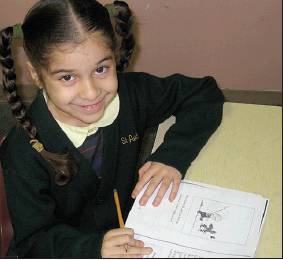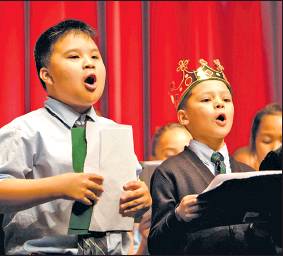Catholic schools thrive in Camden, NJ
The city may lack many resources, but it has an abundance of Catholic elementary school education
BY PETER FEUERHERD
CAMDEN, N.J.. This small city (population 77,000) across the Delaware River from Philadelphia is nationally known for what it lacks: security, resources and, in many cases, hope. It ranks near the top in crime and poverty in listings of American cities.
But one thing it doesn’t lack is schools. There are some 46 elementary and high schools in the city. They are operated by the Camden City School District and a host of charters, both for-profit and nonprofit, funded by the state of New Jersey’s efforts to boost educational achievement.
Four elementary schools in the city, however, do not collect any funds from the state. They are Catholic and are operated by the Catholic Partnership Schools: Sacred Heart, St. Joseph Pro-Cathedral, Holy Name and St. Anthony of Padua. A fifth Partnership School, St. Cecilia, is in nearby Pennsauken and includes students from Camden.
While Camden lacks much, it is abundant in Catholic elementary school education.
“We’re the only ones that offer faith-based education,” said St. Joseph Sr. Karen Dietrich, executive director of the Catholic Partnership Schools, seen as a model to keep Catholic schools afloat in troubled urban areas.
Dietrich emphasized that the schools of the partnership are more than simply staying afloat. By offering innovative programs, including sports, an orchestra, boat-building, aviation, an instructional coach, and afterschool enrichment, Catholic school students in one of America’s poorest cities receive an education comparable to what their better-off neighbors receive.
The average family pays $900-$1,000 for tuition, a significant sum for many Camden families, but well below what other Catholic schools charge. The actual cost per student is around $8,000. The partnership makes up the difference.
As is true in other urban Catholic schools, students in the Catholic Partnership Schools are more likely to graduate from high school than other students in Camden and, this year, one partnership graduate is planning to attend Princeton. One recent standardized test revealed the partnership schools outperform both local charter and public schools by more than two times the proficiency on basic skills.
It’s an old argument, with some saying that Catholic schools in troubled areas do better in large part because paying tuition involves families in the educational process. The tuition cost means “that our parents have some skin in the game,” said Dietrich.
Catholic Partnership Schools began in 2007 when Bishop Joseph Galante, now retired, began a process of evaluating schools in the entire diocese, which spans from Camden to Atlantic City and south to Cape May. In the process, schools were consolidated and regionalized, with a wider base of contributing parishes providing resources.
“But when they looked at Camden city, there was no way that model could apply,” said Dietrich. The parishes in the city were unable to contribute much to schools. A group of South Jerseyans interested in Camden education convened, and the partnership was born, with much early support from local shipbuilder Robert Healey, his daughter, Christine, and the Camden diocese.
The partnership now raises more than $5 million each year through foundation support and other contributions. While other struggling New Jersey cities, such as Trenton, have no Catholic school presence, Camden’s schools thrive, with some having waiting lists.
Ironically, Camden’s struggles have in some ways helped the partnership. Foundations and individual philanthropists know that the city offers an opportunity to make an impact because of its poverty and social issues. The median family income in the city is $24,000. More than a third of Camden’s population is of school age, many of them living in poverty. These children face challenges simply staying alive: Last year, 44 people were murdered in Camden, a per-capita rate far above Chicago’s.
Camden’s struggles caused foundations to take notice, well aware that supporting Catholic education here provided a direct support for poor families seeking a way out of poverty for their children.
“The success comes in telling the stories of our successes,” said Dietrich, who cited the enrichment programs, a cost shared by all five schools, as one notable example. Without the partnership, the individual schools would never be able to afford enrichment programs.
“There is a huge return on investment here. We have stories to tell of students whose lives are challenged,” said Dietrich.
Dietrich is working to spread the Camden partnership model to other places. According to the National Catholic Educational Association, there are an estimated 700,000 students in Catholic elementary and high schools in urban areas. Many serve large numbers of non-Catholics. Each year, the Partnership Schools bring together national experts to discuss educational issues.
Heather Gossart, a senior consultant for the National Catholic Educational Association, noted that urban Catholic school educators often cite the words of the late Cardinal James Hickey of Washington, D.C.: “We don’t educate children because they are Catholic, we educate children because we are Catholic.”
While charter schools have offered a stream of education choice to parents, increasing competition, Catholic schools in urban areas are facing the same challenges they have faced in the past, she said. Costs are increasing, schools are closing and consolidating, and, as is the case in Camden, educators are increasingly seeking funding from philanthropists and foundations that like what they see in the academic and work success of Catholic school graduates.
“That’s the key to it. It takes a whole community,” she said.
Still, urban Catholic schools face new opportunities. Some 29 states offer either vouchers or some other form of parental support for students in Catholic schools, much of it targeted to poverty areas. Schools are also reaching out to the growing Latino population. For example, Latinos now make up 65 percent of the Camden Partnership School population.
“It is our fastest-growing population. It comes to us as predominantly Catholic,” said Gossart.
A recent Boston College symposium offered suggestions on how to better reach Latinos with Catholic school education. Up to now, they have enrolled in Catholic schools in far lower percentages than previous immigrant groups. Tuition costs remain an obstacle, as well as cultural expectations that many Latino immigrants bring from their home countries that Catholic education is only for the elite.
In small, embattled Camden, that is not the case.
[Peter Feuerherd is a correspondent for the
Field Hospital, NCR’s parish life series, and an adjunct journalism professor at St. John’s
University in New York. He previously was communications director for the Camden diocese.]


